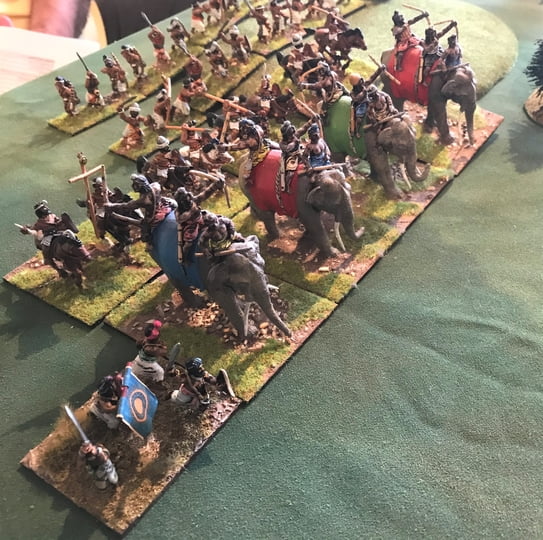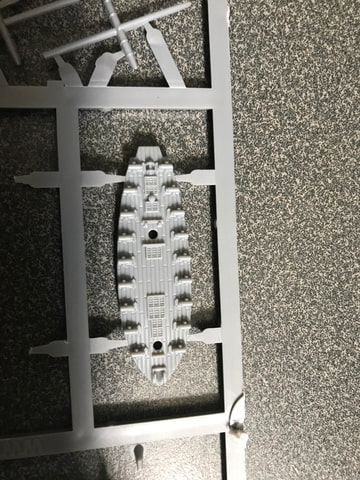This was the last game we played before the current Covid madness crashed down on us. The first dozen units of my Bactrian Greek army had been staring at me accusingly from their shelf. Really needed to get them onto a table for that tricky first run-out and Les agreed to take them on with his contemporary Mauryan Indians (brave man!) I was volunteered to do the rosters for the armies and having see the Indians poor performance at the Battle Day game of The Hydaspes I knew it was going to be tricky to balance the encounter.

Bactrian Greek pike phalanx with Agema cavalry in support.
First of all the Indians would need numbers on their side. In Piquet a single fresh unit of reserves can turn a battle but they would need more than one. I opted for 16 units for the Indians, 12 for the Greeks, a 33% advantage. The details of the Indian force was based on the figures available. There were three elephant units so I pencilled those in straight away (I actually mis-counted and we could have double that up to 6 units using elements of elephant escorts; but who needs more than three?!) The Indian cavalry are no great shakes so they would need them all - 4 units. Also a unit of chariots, light or heavy, they are equally useless. For the infantry the choice was confined to close order bowmen. I added in 8 units, 4 as mercenaries and 4 as militia.

Right wing of the Indian army.
The Indian foot are generally taken to be armed with substantial swords perhaps used two-handed. This would appear to make them a very dangerous close combat opponent but historically they don’t really live up to this, being specifically described as rarely used, by Megasthenes (A Selucid Greek ambassador to Indian courts of the time.) “Indians do not readily fight so amongst themselves” being his assessment. It is curious that soldiers would carry a large and presumably expensive piece of kit if they are not keen on getting stuck in with it. I wonder if it had a more symbolic function; the identifier of its owner as a warrior perhaps?

Left wing and centre of the Indian army (just look at all those elephants!)
The Bactrian Greeks would have 12 units (which matched up neatly with my specifically Bactrian figures.) The available cavalry included 2 units of Iranian / Greek colonist lancers also armed with bows. A unit of guard cavalry or Agema, also lance and bow armed. The fourth unit was a mercenary Skythian horse archer contingent. A solitary unit of elephants was included, pretty much compulsory for this army. The foot was composed of the phalanx; rated as trained militia, so competent but not amazing. I classed their armour as only light, assuming it was all fabric or leather based with bronze helmets but only small pelta type shields. The two units of mercenary Thorakites were similar but with medium armour classification due to their much more substantial shields. This just left a sole unit of Cretan mercenaries, who are classed as Regular missile specialists. They are armed with bows as well as sword and shield.

Right wing of the Bactrian Greek army.
The battle itself saw the Indians line up in a fairly conventional manner with the elephants masking the infantry centre and the right of the line. On their left they massed ¾ of their cavalry on the more open flank with heavy chariots to the fore. Across the field from them the Greeks likewise massed their cavalry and then lined up their phalanx with a unit of Thorakites on each end, the whole line echeloned to the right. On the Greek left was the Cretan archer unit supported by the rather smaller contingent of elephants. The guard Agema were stationed to the rear.

Mercenary thorakites and Cretans protect the Bactrian Greek left.

The Greek first move was to throw forward their Skythian light cavalry to harass the Indian chariots. The bowfire was ineffective but it did prevent the chariots closing with the rest of the Greek cavalry. Following up behind were the Bactrian-Greek lancers (who would have been mostly local Iranians.) These were shot at and thrown into disorder by the Indian chariots as they closed but still pressed home their charge. The lancers own archery was desultory and due to their fighting a disordered formation, the Indians were able to initiate melee immediately. Under Piquet rules however chariots are good shooting platforms and can cause morale checks but are at a disadvantage against cavalry in melee. This offset the disorder of their opponents and the chariots were narrowly beaten and attempted to flee. Not being able to outrun cavalry they took a lot of damage before scattering (off table.) The pursuing lancers now careered into a unit of steady light Indian cavalry. The Indians charged home but against heavier horses and well armoured riders they were again at a disadvantage and immediately broke and fled.


Elephants confront the pike phalanx in the centre.
In the centre the Indian Elephants rolled forward in a stately manner, carefully maintaining their unbroken line but slowed by the low hills they had to navigate. The front unit of the Greek echelon moved up to challenge for the ground and the pike phalanx edged forward so that its flanks rested on low hills. On the left Cretan archers (well-trained mercenaries) skirmished forwards through the woods to dispute that flank with yet more Indian elephants. The Cretans advanced and let fly but were soon running for the cover of the woods as the elephants trundled forwards.

Cretans skulking in the woods.
With the elephants in the centre slowing down their ponderous advance on the pike phalanx and showing no appetite to tackle the mass of spearpoints, the action swung back to the main cavalry fight. The victorious Greek cavalry had reined in from their pursuit but were now charged again by yet another unit of Indian cavalry. With the intervention of their general they just managed to reorder their ranks before the enemy made contact. The result was again the same massacre of the lighter unarmoured Indians. They fled but this time the Greeks did not pursue. (Luckily as they would have gone straight off the table. Instead the opportunity was there ahead of them, the rear of the Indian battle line!

The Bactrian lancers reformed themselves into a fast-moving road column and galloped around the flank of the Indian army. Just in time the Indians had the chance to about turn their back rank of units and avoid a bloody disaster. However one element of the army was not safe(?) behind the row of infantry, their King. Despite being on an elephant he was much too vulnerable against roving cavalry and almost certainly about to be captured or slain. We gave up the game at this point. Mainly in disgust at the ineptitude of the Indian army overall. The discussion was started however as to how to use them to any effect and some ideas were proposed for serious thought. The very clear lesson from the battle was the utter uselessness of Indian cavalry! They have light horses and no armour but do not skirmish or even have a missile weapon!

We will try some tweaks to make the Indians at least playable but trying to stay the right side of history. I still believe that the army is more about causing the enemy to run away, with the Piquet mechanism that allows elephants and chariots to initiate morale challenges and doing that early and often. In addition, our house rule making the infantry swordsmen Fearsome when within a move of the enemy, gives another possibility to damage the enemy morale (automatic morale check if the “Courage!” card is turned.) A few units that are a bit more capable in melee is the missing part of this army and not beyond the bounds of possibility considering they had previously encountered Alexander the Great and seen how it was done properly. Veteran mercenaries or hired foreigners might be a rationalisation for these more capable units. The other route to take is that we use the Indians mainly as allies of the Indo-Greek army and our battles will be the all too typical Indo-Greeks against their countrymen from Bactria.

Indian cavalry about to charge rallying Bactrian lancers in the flank.























































